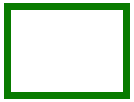5.4: Procedure for Indirect Staining Using an Acidic Dye
- Page ID
- 123351
In negative staining, the negatively charged color portion of the acidic dye is repelled by the negatively charged bacterial cell. Therefore, the background will be stained and the cell will remain colorless.
ORGANISM
Use the pure culture of Micrococcus luteus provided.
PROCEDURE (to be done individually
1. Place a small drop of nigrosin towards one end of a clean microscope slide.
2. Using your sterile inoculating loop, aseptically add a small amount of Micrococcus luteus to the dye and mix gently with the loop.
3. Using the edge of another slide, spread the mixture with varying pressure across the slide so that there are alternating light and dark areas. (See Fig. 1.) Make sure the dye is not too thick or you will not see the bacteria!
4. Let the slide air dry completely on the slide. Do not heat fix and do not wash off the dye.
5. Make sure you carefully pour the used dye in your staining tray down the designated drains located in the three lab benches and not down the sinks used for hand washing.
6. Observe using oil immersion microscopy. Find an area that has neither too much nor too little dye (an area that appears light purple where the light comes through the slide). If the dye is too thick, not enough light will pass through; if the dye is too thin, the background will be too light for sufficient contrast.
Results
|
|
| Shape = Arrangement = |
Contributors and Attributions
Dr. Gary Kaiser (COMMUNITY COLLEGE OF BALTIMORE COUNTY, CATONSVILLE CAMPUS)


